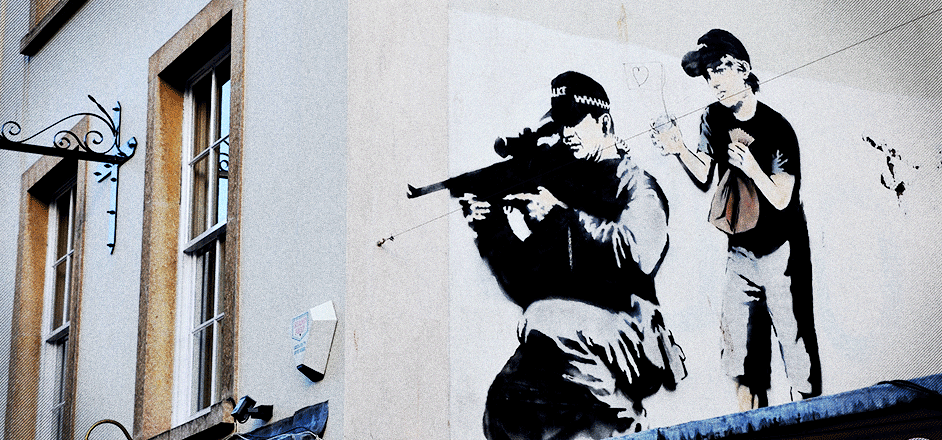Last year Banksy, the anonymous street art king of the UK, opened up his very own art store called “Gross Domestic Product” selling his own home decor and stylized art.
It was an oddly capitalistic move from someone who, in the past has said things like “Copyright is for losers” and who once built a remote shredder into a picture frame to destroy an artwork of his, sold at auction. Banksy’s entire persona is built around art existing outside of the marketplace — beyond capitalism — on walls or billboards, or train-cars — where it will be washed away or covered up eventually. Where it can’t be sold to the highest bidder, to sit in a millionaire’s private art collection.
Naturally, Banksy's store confused some people. But only briefly — because simultaneously Banksy and his lawyer made it publicly clear exactly what they were doing: circumventing a copyright law. Which might have just come back to bite them both in ass.
For some background: at the time he opened Gross Domestic Product, Banksy was suing a greeting card company called Full Colour Black Limited for absconding his iconic images and selling them on their greeting cards, without his permission. It was blatant intellectual theft, and it pissed the hell out of Banksy — rightfully so. Having some corporate nitwits raking cash off his images defiled the entire point of his artwork — it was a corruption of his images and he wasn't going to stand for it.
But, because Banksy didn’t have any copyrights on any of his images (because who the hell copyrights street art?); and because he hadn’t ever made it commercially available himself, the European court deciding the case was going to side with Full Colour Black. They were going to give the business the legal rights to steal Banksy’s art, and to make money pimping it out on their greeting cards.
So, in a clever legal maneuver, Banksy’s legal team (AKA: “Pest Control Services”) launched the Banksy store: Gross Domestic Product – "where life irritates art." And they did so, overtly to circumvent the law — to create a commercial element to Banksy, so that Full Colour Black couldn’t continue using his images. The reasoning went something like this: if Banksy finally caved and sold his art like a shill — even at a pop-up façade of a store — the greeting card people couldn’t continue to legally steal from him.
“This shop has come about as a result of legal action.” Banksy wrote frankly, in a statement when he opened Gross Domestic Product. “A greetings card company is trying to seize the legal name Banksy from the artist, who has been advised the best way to prevent this is to sell his own range of branded merchandise.”
Banksy’s lawyer outlined this strategy to the press as well, calling the case “frankly ludicrous.”
Sadly, however, that legal gambit didn’t pay off — and may have actually swung back around to completely kick the legs out from under Banksy’s entire trademark portfolio.
In a scorching public response, the court deciding this matter made it very clear that they will not be cutting the anonymous street artist any slack. By their word, Banksy’s EU trademark has been “declared invalid in its entirety.”
“Banksy has chosen to remain anonymous and for the most part to paint graffiti on other people’s property without their permission rather than to paint it on canvases or his own property.” The court wrote. “He has also chosen to be very vocal regarding his disdain for intellectual property rights, although clearly his aversion for intellectual property rights does not annul any validly acquired rights to copyright or trademarks. It must be pointed out that another factor worthy of consideration is that he cannot be identified as the unquestionable owner of such works as his identity is hidden.”
But the real nail in the coffin, wasn’t either of those factors. It was the comments that Banksy and his lawyers made when they opened Gross Domestic Product.
The court’s decision continued: “By their own words, [Pest Control Office] admit that the use made of the sign was not genuine trademark use in order to create or maintain a share of the market by commercialising goods, but only to circumvent the law.” A move that the court said was “inconsistent with honest practices.”
So, in the spirit of “honesty,” the court is siding with the commercial thieves, giving them the rights to artwork they didn’t make and never had permission to use.
“I think the key problem for Banksy was that he said little or nothing about his plans other than the public statements around the pop-up,” said the lawyer for Full Colour Black. “Frankly, they were disastrous for his case, and whilst bad faith is difficult where one has to mosaic together behaviour, it is far easier where the party seals their own doom.”
This essentially means that now, any commercial business that wants to steal Banksy’s images or artwork can do so, legally, and sell them for their own profit: on greeting cards, posters, reprints, clothing, jewelry, NFT’s… this could mean "open season" for businesses on Banksy’s uncopyrighted artwork now.
So, don’t be surprised when you start seeing his iconic rats, flower girls, and stylized graffiti plastered on products around Europe — and probably everywhere around the world. It isn’t that Banksy sold out. It’s that The Man just gave the commercial market the go-ahead to steal from him.




Leave a Reply